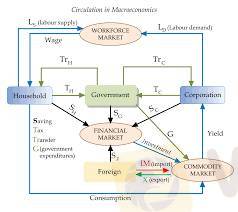
2025-02-06 09:34
業內Macroeconomics theory
#firstdealofthenewyearastylz
Macroeconomics is a branch of economics that studies the behavior and performance of an economy as a whole. It focuses on aggregate changes and the overall functioning of the economy, rather than individual markets. Here are the key components and theories of macroeconomics:
1. Aggregate Demand and Supply: Macroeconomics analyzes the total demand (aggregate demand) and total supply (aggregate supply) in an economy. Aggregate demand is the total quantity of goods and services demanded across all levels of the economy at a given overall price level, while aggregate supply is the total production of goods and services at a given price level.
2. National Income Accounting: This involves measuring a country's economic performance through indicators like Gross Domestic Product (GDP), Gross National Product (GNP), and Net National Product (NNP). GDP measures the total value of all goods and services produced over a specific time period within a country.
3. Business Cycles: Macroeconomics studies the fluctuations in economic activity over time, known as business cycles. These cycles consist of periods of expansion (growth) and contraction (recession) and are influenced by various factors including consumer confidence, investment, and government policies.
4. Monetary Policy: This refers to the actions taken by a country's central bank to control the money supply and interest rates to achieve macroeconomic objectives such as controlling inflation, consumption, growth, and liquidity. Tools include open market operations, discount rates, and reserve requirements.
5. Fiscal Policy: This involves government spending and taxation policies to influence economic conditions. By adjusting spending levels and tax rates, governments can impact overall economic activity, aggregate demand, and employment levels.
6. Inflation and Unemployment: Macroeconomics examines the relationship between inflation (the rate at which the general level of prices for goods and services rises) and unemployment (the percentage of the labor force that is jobless). The Phillips Curve illustrates this trade-off, suggesting that lower unemployment can lead to higher inflation.
7. Economic Growth: This aspect focuses on the long-term increase in a country's productive capacity, often measured by GDP growth. Factors that contribute to economic growth include technological advancements, capital accumulation, and improvements in labor productivity.
8. International Economics: Macroeconomics also considers how economies interact on a global scale, including trade balances, exchange rates, and the impact of international policies on domestic economies.
Overall, macroeconomic theory provides a framework for understanding how economies operate and how various factors influence economic performance. It helps policymakers design strategies to promote economic stability and growth.
My AI currently does not provide accurate information for events that occurred after December 2023. Please check other reliable sources for more up-to-date information.
贊 0

Monix
Mga broker
熱門討論
業內
哎,现在明白不赌就是赢啊
行情分析
美元/加元技术面
技術指標
外汇技术分析之波浪理论
業內
[活動]論交易,贏取200元話費補貼
技術指標
EZ.Fury Kite是基于趋势指标MA进行判断
技術指標
指标派是什么?
市集分類

平臺

展會

代理商

招聘

EA

業內

行情

指標
Macroeconomics theory
 香港 | 2025-02-06 09:34
香港 | 2025-02-06 09:34#firstdealofthenewyearastylz
Macroeconomics is a branch of economics that studies the behavior and performance of an economy as a whole. It focuses on aggregate changes and the overall functioning of the economy, rather than individual markets. Here are the key components and theories of macroeconomics:
1. Aggregate Demand and Supply: Macroeconomics analyzes the total demand (aggregate demand) and total supply (aggregate supply) in an economy. Aggregate demand is the total quantity of goods and services demanded across all levels of the economy at a given overall price level, while aggregate supply is the total production of goods and services at a given price level.
2. National Income Accounting: This involves measuring a country's economic performance through indicators like Gross Domestic Product (GDP), Gross National Product (GNP), and Net National Product (NNP). GDP measures the total value of all goods and services produced over a specific time period within a country.
3. Business Cycles: Macroeconomics studies the fluctuations in economic activity over time, known as business cycles. These cycles consist of periods of expansion (growth) and contraction (recession) and are influenced by various factors including consumer confidence, investment, and government policies.
4. Monetary Policy: This refers to the actions taken by a country's central bank to control the money supply and interest rates to achieve macroeconomic objectives such as controlling inflation, consumption, growth, and liquidity. Tools include open market operations, discount rates, and reserve requirements.
5. Fiscal Policy: This involves government spending and taxation policies to influence economic conditions. By adjusting spending levels and tax rates, governments can impact overall economic activity, aggregate demand, and employment levels.
6. Inflation and Unemployment: Macroeconomics examines the relationship between inflation (the rate at which the general level of prices for goods and services rises) and unemployment (the percentage of the labor force that is jobless). The Phillips Curve illustrates this trade-off, suggesting that lower unemployment can lead to higher inflation.
7. Economic Growth: This aspect focuses on the long-term increase in a country's productive capacity, often measured by GDP growth. Factors that contribute to economic growth include technological advancements, capital accumulation, and improvements in labor productivity.
8. International Economics: Macroeconomics also considers how economies interact on a global scale, including trade balances, exchange rates, and the impact of international policies on domestic economies.
Overall, macroeconomic theory provides a framework for understanding how economies operate and how various factors influence economic performance. It helps policymakers design strategies to promote economic stability and growth.
My AI currently does not provide accurate information for events that occurred after December 2023. Please check other reliable sources for more up-to-date information.
贊 0
我也要評論
提問
0條評論

還沒人評論,趕緊搶佔沙發

提問
還沒人評論,趕緊搶佔沙發